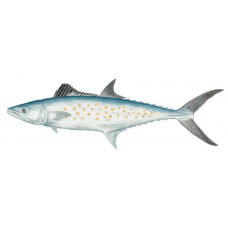Latin name
Scomberomorus maculatus
Other names
Atlantic Spanish mackerel; Portuguese: sororoca; Spanish: carite, pintada, sierra, sierra pintada.
Identification
The slender, elongated body of the Spanish mackerel is silver with a bluish or olive green back. There are 16-18 spines on the first dorsal fin, 15-18 soft rays on the second dorsal fin, followed by 8-9 fins, and 13-15 gill rakes on the first arch. The lateral line curves down evenly to the base of the tail. Spanish mackerel are similar to cero mackerel and king mackerel, but they have bronze or yellow spots without stripes. Spanish mackerel have no scales on their pectoral fins, further distinguishing them from both cero and king mackerel, which have scales on them. In addition, the anterior part of the first dorsal fin of the Spanish mackerel is black, whereas in the king mackerel it is more blue, and the second dorsal and pectoral fins may be fringed in black.
Distribution
There are two distinct populations of Spanish mackerel in the western Atlantic: one in the Gulf of Mexico and one along the main west Atlantic coast. The first extends from the Gulf of Mexico across Florida to the Yucatán, and the second extends from Miami to the Chesapeake Bay and sometimes to Cape Cod. They are absent from the Bahamas and Antilles, except around Cuba and Haiti, and are abundant around Florida.
Habitat
Occurring onshore, nearshore, and offshore, Spanish mackerel prefer open water, but can sometimes be found in deep bottoms and reefs, as well as in shallow estuaries. They form large, fast-moving flocks that migrate long distances along the coast, remaining in waters above 68 °F. These swarms are found off North Carolina in April, off Chesapeake Bay in May, and off New York City in June, and return south in winter.
Size
Spanish mackerel grow to 37 inches and 11 pounds, averaging 11⁄2 to 3 feet and 2 to 3 pounds. The record holder of all tackle is a 13-pound specimen caught off the coast of North Carolina in 1987. Fish over 5 years old are rare, although some are as old as 8 years old.
Life history and Behavior
Spanish mackerel, unable to reproduce in their second year and spawn in the sea from April to September.
Food and feeding habits
Spanish mackerel feed mainly on small fish as well as squid and shrimp. They often knock their prey down and practically push the fish out of the water while feeding.
Reproduction
No information
| Classification | |
| Phylum | Chordata |
| Class | Actinopterygii |
| Squad | Scombriformes |
| Family | Scombridae |
| Genus | Scomberomorus |
| Species | S. maculatus |
| Features | |
| Conservation status | Least Concern |
| Habitat | Pelagic |
| Life span, years | 11 |
| Maximum body weight, kg | 5.9 |
| Maximum length, cm | 91 |
| Sailing speed, m/s | No information |
| Threat to people | Edible |
| Way of eating | Predator |



